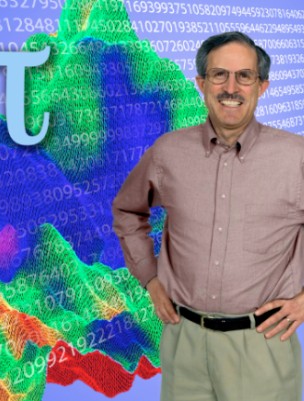-
(b.) - ?1948
Bio/Description
A mathematician and computer scientist, he received his B.S. degree in Mathematics from Brigham Young University in 1972 and his Ph.D. in Mathematics from Stanford University in 1976. From 1976 until 1984, he worked as an applied mathematician with the Department of Defense, near Washington, D.C., with ESL Inc. of Sunnyvale, California, and then with SRI International in Menlo Park, California. He worked for 14 years as a computer scientist at NASA Ames Research Center, but since 1998 has been at the Lawrence Berkeley National Laboratory (Berkeley Lab) in California. He is now officially retired, but continues as an active researcher. He is a Research Fellow at the University of California, Davis, Department of Computer Science. He is perhaps best known as a co-author (with Peter Borwein and Simon Plouffe) of a 1997 paper that presented a new formula for π (pi). This Bailey?Borwein?Plouffe formula permits one to calculate binary or hexadecimal digits of pi beginning at an arbitrary position, by means of a simple algorithm. He was the writer of the computer program that enabled the discovery of the formula by Simon Plouffe. More recently (2001 and 2002), he and Richard Crandall showed that the existence of this and similar formulas has implications for the long-standing question of "normality" ? whether and why the digits of certain mathematical constants (including pi) appear "random" in a particular sense. He is a long-time collaborator with Jonathan Borwein (Peter's brother). They are co-authors of numerous papers and three books on experimental mathematics. He also does research in numerical analysis and parallel computing. He has published studies on the fast Fourier transform (FFT) on advanced computer architecture, high-precision arithmetic, and the PSLQ algorithm (used for integer relation detection). Techniques that he subsequently developed with Paul Swarztrauber of NCAR are now the basis of FFT routines available on supercomputers from Cray and other vendors. Co-author of the NAS Benchmarks, which are used to assess and analyze the performance of parallel scientific computers; in 1984 he developed the "NAS Kernels," which were later incorporated into the SPEC suite. Then in 1991 he and several colleagues at Ames developed the "NAS Parallel Benchmarks". Performance results on this suite are now widely cited in the parallel computing community. His essay "Twelve Ways to Fool the Masses" is often cited by scientists when discussing questionable parallel performance reports. He has also published articles in the area of mathematical finance, including a 2014 paper with Jonathan Borwein, Marcos Lopez de Prado and Qiji Jim Zhu: "Pseudo-mathematics and financial charlatanism: The effects of backtest overfitting on out-of-sample performance". Notices of the AMS 61 (5): 458?471. 2014. doi:10.1090/noti1105. This work emphasizes the dangers of backtest overfitting in the financial field. Other works he has co-authored are: with Robert F. Lucas, Samuel Williams (eds.): Performance tuning of scientific applications. Chapman & Hall/CRC Computational Science Series, CRC Press 2010, ISBN 9781439815694; with Jonathan Borwein, Neil Calkin, Roland Girgensohn, D. Russell Luke, Victor Moll: Experimental mathematics in action, A. K. Peters 2007; and with Michał Misiurewicz: "A strong hot spot theorem". Proc. Amer. Math. Soc. 134 (9): 2495?2501, 2006, MR 2213726. In 1993, he received the Sidney Fernbach award from the IEEE Computer Society, "For contributions to numerical computational science including innovative algorithms for FFT's, matrix multiply and multiple precision arithmetic on vector computer architecture". In addition, he was awarded the Chauvenet Prize and the Hasse Prize from the Mathematical Association of America. In 2005 he was a finalist for the $100,000 Edge of Computation Science Prize, and in 2008 he was a co-recipient of the Gordon Bell Prize from the Association for Computing Machinery. In addition to his technical work in mathematics and computer science, he has written articles on science and religion, emphasizing the pointlessness of war between science and religion. He is the editor of the Science Meets Religion website, a repository of articles and information on issues at the juncture of science and religion. He is affiliated with The Church of Jesus Christ of Latter-day Saints.
-
Date of Birth:
1948 -
Noted For:
Writer of a software program to compute the mathematical constant pi to high precision which is now used by scientists world-wide for research in both pure and applied mathematics -
Category of Achievement:
-
More Info:


